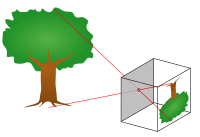Difference between revisions of "Translations:Adventist Youth Honors Answer Book/Arts and Crafts/Digital Photography/2/en"
From Pathfinder Wiki
(Importing a new version from external source) |
(Importing a new version from external source) |
||
| Line 1: | Line 1: | ||
| − | ==1. Explain the following:== | + | ==1. Explain the following:== |
===a. The principles of digital camera construction and how a digital camera works. === | ===a. The principles of digital camera construction and how a digital camera works. === | ||
[[Image:Pinhole-camera.svg|thumb|right|200px|Principle of a pinhole camera. Light rays from an object pass through a small hole to form an image.]] | [[Image:Pinhole-camera.svg|thumb|right|200px|Principle of a pinhole camera. Light rays from an object pass through a small hole to form an image.]] | ||
Cameras work with the light of the visible spectrum. A camera generally consists of some kind of enclosed hollow, with an opening or aperture at one end for light to enter, and a recording or viewing surface for capturing the light at the other end. Most cameras have a lens positioned in front of the camera's opening to gather the incoming light and to focus the image (or part of the image), on the recording surface. The diameter of the aperture is often controlled by a diaphragm mechanism, but some cameras have a fixed-size aperture. | Cameras work with the light of the visible spectrum. A camera generally consists of some kind of enclosed hollow, with an opening or aperture at one end for light to enter, and a recording or viewing surface for capturing the light at the other end. Most cameras have a lens positioned in front of the camera's opening to gather the incoming light and to focus the image (or part of the image), on the recording surface. The diameter of the aperture is often controlled by a diaphragm mechanism, but some cameras have a fixed-size aperture. | ||
Latest revision as of 20:03, 9 January 2021
1. Explain the following:
a. The principles of digital camera construction and how a digital camera works.
Cameras work with the light of the visible spectrum. A camera generally consists of some kind of enclosed hollow, with an opening or aperture at one end for light to enter, and a recording or viewing surface for capturing the light at the other end. Most cameras have a lens positioned in front of the camera's opening to gather the incoming light and to focus the image (or part of the image), on the recording surface. The diameter of the aperture is often controlled by a diaphragm mechanism, but some cameras have a fixed-size aperture.

